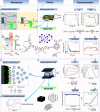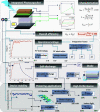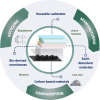Progress of Photocapacitors
- PMID: 37294781
- PMCID: PMC10416220
- DOI: 10.1021/acs.chemrev.2c00773
Progress of Photocapacitors
Abstract
In response to the current trend of miniaturization of electronic devices and sensors, the complementary coupling of high-efficiency energy conversion and low-loss energy storage technologies has given rise to the development of photocapacitors (PCs), which combine energy conversion and storage in a single device. Photovoltaic systems integrated with supercapacitors offer unique light conversion and storage capabilities, resulting in improved overall efficiency over the past decade. Consequently, researchers have explored a wide range of device combinations, materials, and characterization techniques. This review provides a comprehensive overview of photocapacitors, including their configurations, operating mechanisms, manufacturing techniques, and materials, with a focus on emerging applications in small wireless devices, Internet of Things (IoT), and Internet of Everything (IoE). Furthermore, we highlight the importance of cutting-edge materials such as metal-organic frameworks (MOFs) and organic materials for supercapacitors, as well as novel materials in photovoltaics, in advancing PCs for a carbon-free, sustainable society. We also evaluate the potential development, prospects, and application scenarios of this emerging area of research.
Conflict of interest statement
The authors declare no competing financial interest.
Figures







References
-
- Boukortt N. E. I.; Patanè S. Single junction-based thin-film CIGS solar cells optimization with efficiencies approaching 24.5. Optik 2020, 218, 165240.10.1016/j.ijleo.2020.165240. - DOI
-
- Bailie C. D.; Christoforo M. G.; Mailoa J. P.; Bowring A. R.; Unger E. L.; Nguyen W. H.; Burschka J.; Pellet N.; Lee J. Z.; Grätzel M.; Noufi R.; Buonassisi T.; Salleo A.; McGehee M. D. Semi-transparent perovskite solar cells for tandems with silicon and CIGS. Energy Environ. Sci. 2015, 8, 956–963. 10.1039/C4EE03322A. - DOI
-
- Feurer T.; Reinhard P.; Avancini E.; Bissig B.; Löckinger J.; Fuchs P.; Carron R.; Weiss T. P.; Perrenoud J.; Stutterheim S.; Buecheler S.; Tiwari A. N. Progress in thin film CIGS photovoltaics – Research and development, manufacturing, and applications. Progress in Photovoltaics: Research and Applications 2017, 25, 645–667. 10.1002/pip.2811. - DOI
-
- Wang S.; Tan L.; Zhou J.; Li M.; Zhao X.; Li H.; Tress W.; Ding L.; Graetzel M.; Yi C. Over 24 perovskite solar cells. Joule 2022, 6, 1344–1356. 10.1016/j.joule.2022.05.002. - DOI
-
- Jeong J.; Kim M.; Seo J.; Lu H.; Ahlawat P.; Mishra A.; Yang Y.; Hope M. A.; Eickemeyer F. T.; Kim M.; Yoon Y. J.; Choi I. W.; Darwich B. P.; Choi S. J.; Jo Y.; Lee J. H.; Walker B.; Zakeeruddin S. M.; Emsley L.; Rothlisberger U.; Hagfeldt A.; Kim D. S.; Gratzel M.; Kim J. Y. Pseudo-halide anion engineering for α-FAPbI3 perovskite solar cells. Nature 2021, 592, 381–385. 10.1038/s41586-021-03406-5. - DOI - PubMed
Publication types
LinkOut - more resources
Full Text Sources
Miscellaneous

